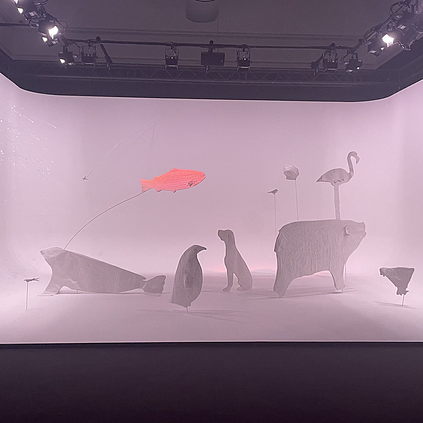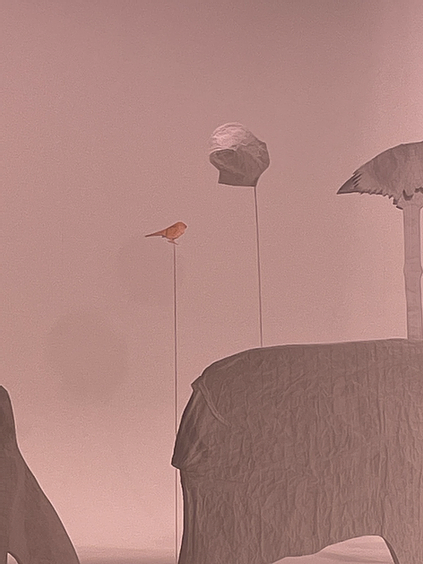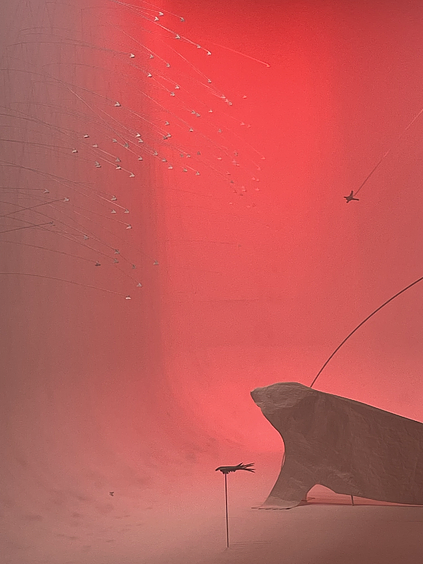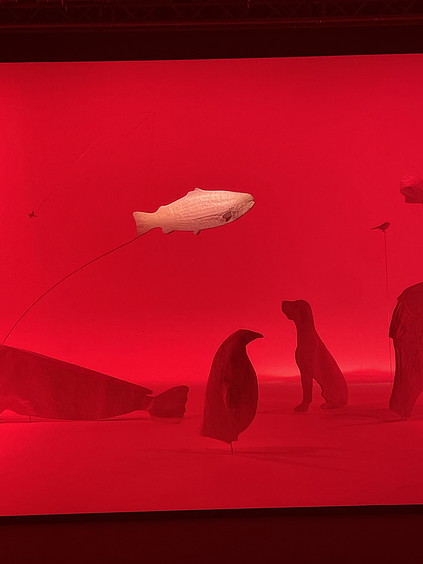Cooking Sections @ Tate Britain
Emoji summary: 🐟 🍽 🔎
I went to see something at the Tate, and I liked it. Yes, yes, I know.
Tate Britain’s lil Art Now room is currently hosting a work by Cooking Sections; it’s called <Salmon: A Red Herring>. Cooking Sections is a duo: Daniel Fernandez Pascual & Alon Schwabe, and the whole thing is a bit buzzy bc they have been nominated for this year’s Turner Prize, in a round where all the nominees are collectives. It’s all very neat & cute, good vibes.
The work itself is a dramatic set stage, like a diorama all in white; we are peeping in through the 4th wall. Across the lil diorama are these clean minimalist sculptures, like papier-maché but flat-packed: a seal, a penguin, a dog, a pig, a flamingo. Above them all, is a salmon; it dangles over into the dead airy space in the middle. As I walk in, the lights are low and everything is still. When it all kicks in, I jump a lil bit. The lights come up, and the salmon is lit up pink. A voice narrates.
The script winds around: Salmon is a colour and a fish, we think Salmon (the fish) is meant to be salmon (the colour), but most of the Salmon people eat isn’t salmon-coloured, because most of the Salmon people eat is farmed Salmon, which is grey rather than salmon (the colour). So Salmon farmers use synthetic salmon pigments in Salmon feed to make Salmon (the fish) salmon (the colour). This process is industrial, chemical, and has catastrophic impact on ecosystems beyond one singular fish. The script plays up a dark comedy in the delivery, between salmon-pink Salmon and the speed as it twists between. The lights flash through salmon-pink colour swatches to show us all the options available to an aesthetically discerning Salmon farmer, now the salmon is pink, now the room is pink, now the pig is pink; colour seeps across the diorama like a painful blush, now it is like sunburn, blistering.
The script exists in a way that stretches all my favourite muscles. I love it when art does that Thing; where it draws together disparate ideas, makes them cogent, coherent, dynamic. I love it when art can laser focus some critical attention in on a thing, open up a window into another space, or make a collection of things look brand new in the controlled setting of its canvas. It feels like a powerful and compelling mix, and it makes me believe in art as a language and use of our collective time. Satisfying, yes yes yes, art is doing its Thing™️. And the script does that, for sure. It points at spaces, identifies the way it all connects; art is art, but art is also geopolitics, climate study, marine biology, power structures. The lights flash, it is spectacular and in the dark it all feels cinematic. Farmed Salmon aren’t salmon anymore, so they are fed salmon pigments; shrimp are no longer pink because of insecticides; a group of stray dogs jumped in India’s Yamuna river and were dyed in this season’s hottest colours because of the chemicals pumped out by the fast fashion factories upstream. Human Animal Colour Ecosystem. It hits me like those slow-mo Matrix action shots; boom, boom, boom.
The world is wild and unweildy, and there is something comforting and warm in art’s ability to make non-sequitur devastation feel ordered and linked. There is a reason Adam Curtis has a kind of chokehold on middle-class society. But. The ordering isn’t the end. Just organising ideas and chaotic atrocities is no longer enough, I think I want more than just a vague pointing at an area and hoping the gesture of attention and coherence will be enough. I think the road has run out beneath me, and this is where my feelings get sticky.
Alongside the lil Art Now show, Tate have announced: ‘as the core part of the exhibition, Tate has permanently removed farmed salmon from its food outlets at all four sites across the UK. This institutional commitment prompted by Cooking Sections is part of a broader pledge to interrogate our systems, our values and our programmes, and become more globally adaptive and responsible in the face of climate emergency. This commitment is an intrinsic element of <Salmon: A Red Herring> and will form the cornerstone of the project’s legacy at Tate.’ Tate Eats have overhauled their menu, the dishes that had Salmon have been reworked to now use ‘ingredients that promote regenerative aquacultures’; it’s a collaborative effort between Cooking Sections, the Tate’s various curatorial departments, and Tate’s Commerce wing.
Tbqh I am not a big enough person to not be petty and resentful about the level and ease of this as a significant meaningful change to Tate’s operations. Can’t lie, it stings. I am jealous of it, frustrated by it, and kinda amused? Because while it is an ok-good thing, that in my guilty environmentally concerned core, I cannot pick a proper fight with; the fanfare and smoothness of it all grates me and leaves me dry.
I will use this review as my yearly reminder that: the Tate is a flagship publicly funded institution, its size scale and weight means that it is Ours to make demands of, with an entitlement that potentially doesn’t completely copy over to other institutions. They operate on a scale that is the size of the nation, the state, conglomerate and titan. There are a multitude of other systemic changes that Tate need to be getting on with, sharpish. I laughed to myself at how big a deal was made of this quite small and manageable administrative detail; on the press release, the website, the BBC Radio Four Food Programme press special. It IS funny, but also. We can see a route towards those other changes being made possible (regardless of how we feel about longevity or ideological purity) by piggybacking them onto art. Let me be nice, optimistic, a Good Vibes Person. Maybe change is possible from within a system if maybe, just maybe we tack it onto the terms of exhibition and display.
The road underneath me just runs out when the gesturing is so insular and restricted, hard-won and piecemeal. I am split between wanting to enjoy the good change, and being cynical and hardline. Split between being in awe of the scale that abstraction can inflate a problem to, that this isn’t just about Salmon, but rather the way human-kind at large interacts with the very idea of colour; and wanting to scream, because that scale just turns problem into spectacle. I don’t know what to think. I keep moving to write the takedown, but my fingers ignore my head, they are optimistic as they type type type. I am just hungrier than this all, and I would like more, would like other fights to be just as easy. This split doesn’t really register in the gallery, though. It only hits when you walk out, read the handout on the tube and absorb the marketing copy. In the moment, this show is the kind of enveloping drama I’ve been looking for post-lockdown. I liked it against my will.
Cooking Sections' Art Now Show, <Salmon: A Red Herring> is on at Tate Britain until 31st August.



